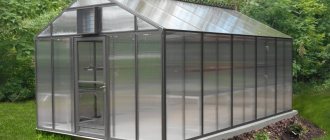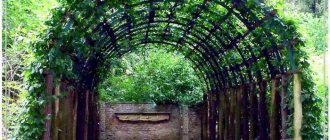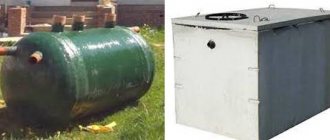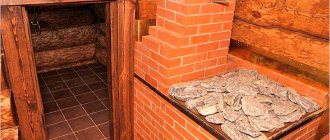The coming winter is an important time for flower growers on our forum. Users of our portal study thick books on floristry and landscape design, draw mixborder schemes, discuss them with their accomplices and redraw them. It's really difficult to create a real mixborder. As a forum member with the nickname Grandma Irisha noted, “all last winter I read, looked at beautiful pictures of landscapers, - so what? You go to your site with that piece of paper with the drawings and a shovel... nothing emerges. All that remains is to plant where your left foot whispers to your right ear.”
What plants are suitable for mixborders?
To create a “mix” of beautifully flowering plants, you should pay attention to the following parameters:
- location;
- amount of sunlight;
- shading;
- forms of crops (shrubs, herbs);
- site size.
Bordering paths with a mix of flowering plants Source rehouz.info
A mixborder is not a chaotic planting of plant crops, but a beautiful flowerbed with decorative elements, where flowering continues throughout the season. Snowdrops, which bloom in early spring, are considered to be the first “swallows” of mixborders. Then bulbous and perennial herbs take up the baton. Asters and chrysanthemums finish blooming in such flower beds.
The main difference between planting plants in the form of a mixborder is the free placement of plants in it, smoothly flowing into each other. Such a composition should contain plants that create a “winter effect” and give the shape and height of the entire “fragrant island”. Landscape design specialists call them “skeletal” forms.
Bright mixborder Source dekoriko.ru
After preparing the soil and dividing the area into unequal shares, they begin to plant the background of the mixborder, planting bulk crops with leaves of unusual shape. Then tall flowers with straight stems are planted. Next, they begin to place medium-sized crops devoid of lush foliage. Finally, low “ground covers” and annuals are planted. The described order of tiered placement allows you to “mask” the elongated shoots of flowers occupying the middle ground.
Creation tips for beginners
Despite the fact that you can find a lot of ready-made diagrams on the Internet and read all the necessary information, creating a mixborder with your own hands is not so easy. Planting such a flower bed requires the gardener not only basic knowledge, but also experience. Therefore, we have prepared basic rules that will be useful at the initial stage:
- Consider the existing conditions. Light level, soil acidity and composition, wind strength, minimum and maximum temperatures.
- Study the proposed plants. Typically, seed packages indicate the flowering period, plant size, and requirements for growing conditions.
- Decide on the appearance. Which style and palette will suit you best?
- Start by choosing skeletal plants. Dense shrubs that maintain their appearance from spring to autumn or all year round. The distances between them will later be filled with small annuals.
- Don't go overboard with the quantity. Many different species in several copies form a mess, it is better to choose a maximum of 3 tall, medium, low plants. This is usually sufficient.
Important! Don’t forget the main thing: a mixborder is a living organism. Therefore, in order for it to remain in good condition, it requires constant care, which consists of watering, weeding, pruning, and removing yellowed sectors.
How to make a mixborder from conifers and shrubs: ready-made flower bed schemes
A mixborder of conifers and shrubs serves as a classic example of the use of plants. Such “flower beds” are located in different areas:
- near outbuildings;
- along fences;
- near houses.
Coniferous plantings in such a flower garden play the role of a “skeleton” that determines the height and outline of the entire composition. Therefore, these crops are planted in the background of the mixborder, which is located near the walls.
Mixborder in the yard Source vk.com
The central place is given to conifers when arranging combined compositions in free areas. The lower tier of such a flower garden can be occupied by:
- lilac;
- hibiscus;
- magnolia;
- elder.
When creating a mixborder from conifers, when supplementing it with broad-leaved forms, one should take into account the intensity of growth processes in broad-leaved shrubs, preventing them from exceeding coniferous ones.
Well-chosen plants Source www.galangpratama.com/
See also: Catalog of companies that specialize in landscaping work on sites.
Benefits of use
It is no coincidence that many people love such flower beds. They have a number of advantages over conventional classic flower beds or borders:
- Easy disembarkation
- Possibility of use in a small area
- Visual increase in site space
- Creating compositions from a large number of plants
- Colorful blooms throughout the season
- Picturesque height difference and the possibility of vertical design
- Easy to care for
Organizing such landscape decoration does not require special knowledge. Therefore, it is accessible even to a child or a novice gardener.
Ready-made schemes for mixborders made from perennials
Another interesting design option is mixborders made from perennials. After determining the shape of the composition and size, you should select skeletal plants that can set the height of the flower bed. For these purposes you can take:
- elderberry;
- magnolia;
- hydrangea;
- hibiscus;
- jasmine;
- shrubs and trees of dwarf formations.
Proper organization of a mixborder Source stroy-podskazka.ru
When creating mixborders from perennials, it is necessary to remember the tendency of these crops to grow, so it is advisable to place them not close. To make the display natural, you should maintain different distances between the skeletal bushes.
After filling the center of the flowerbed, we proceed to its middle part. Here you can drop off:
- Heuchera;
- phlox;
- aster;
- delphinium;
- rose.
Large flower garden with peonies Source flowers.cveti-sadi.ru
To dilute the composition, perennial grasses should be planted:
- sagebrush;
- geranium;
- juniper;
- Cineraria.
Deciduous shrubs Source stozabot.com
It is advisable to plant small, bright perennials in the foreground of the resulting mixborder:
- violet;
- bell;
- carnation;
- lily.
The resulting mixborder, the diagram of which is presented above, will create a fragrant atmosphere in the garden and be easy to maintain.
Plant placement diagram for a mixborder Source adventureda.blogspot.com
Mixborder with peonies: diagram
To create a mixborder of perennial peonies, you need to correctly select the right varieties so that the composition blooms for a long time and is pleasing to the eye.
Lupines in a flowerbed Source youla.ru
Moderately dry mixborders can be diluted with thin-leaved peony, which is highly resistant to disease. This look looks great with:
- broom;
- wormwood;
- flax;
- granular camelonka;
- gorse;
- Eremurus.
It is advisable to devote the first decade of summer to cutting sprouted peonies and planting delphinium, phlox or lilies between them. Foxglove lupins and clematis can create verticals in such a composition. After the peonies bloom, the decorativeness of the mixborder can be complemented by their dark green leaves, which serve as an excellent background.
Unusual bright combinations Source rehouz.info
Advice from experienced flower growers
To create a mixborder of perennial flowers that bloom at the same time, ground cover roses are suitable. You can alternate them with fills or, for example, perennials that give a clear outline - for example, hostas or daylilies. But they all grow and will still have to be dug up and divided every 3-4 years (except for roses). You can combine roses, for example, with spherical thujas (small ones, for example Danika).
LEKA77
https://www.forumhouse.ru/threads/42603/page-2
Perennials are good because they can grow for a long time in one place, but at the same time their flowering period is short. Among perennials, I prefer plants that do not lose their decorative qualities after flowering in our heat, therefore: roses, lavender, daylilies, daisies, under trees - hostas, astilbes, bergenia, ferns, heucheras.
Kiti
https://www.forumhouse.ru/threads/42603/
Derain, spirea (gray, with a white waterfall), lilac (also white), hydrangeas go well together). They do not require any special soil conditions; the slightly acidic reaction of the soil environment will suit everyone, and details can be adjusted during planting and further care. Nobody likes getting wet and buried, this needs to be taken into account. If you are looking for easy ways, then give up shrubs that are obviously unstable in our climate (unstable wintering and irregular flowering). Be sure to consider the plant’s relationship to light, this is important.
Chigs
https://www.forumhouse.ru/threads/42603/page-2
Mixborders from perennials: diagrams and names
When creating mixborders from perennials, the following parameters must be taken into account:
- viewing angle;
- landing place;
- multi-tiered compositions;
- competent selection of plants;
- type of root system;
- photosensitivity.
The appearance of wilted and dried forms should not disturb the harmony of the entire flower arrangement. Proper placement of decorative greenery allows the flower bed not to lose its attractiveness even after withering.
Mix of evergreen conifers Source rehouz.info
Depending on the preferences of the owners, the mixborder can be designed in different stylistic directions:
- English style. It is popular in strictly planned areas where restrained colors dominate. The emphasis is on plants with leaves of unusual color and shape. A combination of garden perennials and wild species is welcome. Often such flower beds are planted with ornamental cereals, verbena, hostas, park roses, and mantles.
- Meadow style. This direction is popular among lovers of the unpretentious and delicate beauty that dominates meadow herbs. Such mixborders are rich in ornamental grains, flax, poppies and daisies.
- Country motives. This style calls for bright flowering perennials with lots of greenery. Plantings of lupines with berry bushes (currants, viburnum) are popular.
Even in the garden beds, you can create your own “vegetable” mixborder by planting decorative vegetable crops and “curly” greens in it. In this case, spicy and medicinal herbs can become color accents.
Mixborder in pink tones Source www.botanichka.ru
When organizing any mixborder, it is important to highlight its contours, tying them to the existing terrain. To obtain a spectacular result, it is recommended to make the lines of the resulting flower bed more graceful. Much attention should be paid to the presence of obstacles (buildings, trees) and taking into account elevation changes.
Mixborder with lavender
Lavender is an exquisite plant with a subtle aroma and attractive flower stalks. Such characteristics allow you to safely include this crop in different flower beds and mixborders. An additional advantage of such plants is their ease of care.
When including lavender in a mixborder, you should select species that are not able to block the rays of the sun from it. This plant organically combines with the following color scheme:
- pink;
- orange;
- white;
- yellow;
- blue;
- dark purple.
To create this palette, you should plant sedum, sage, and poppies next to lavender.
Mixborder with stones
The inclusion of additional decorative elements in the mixborder allows you to present the resulting flower arrangement in a new way. In this case, you should be careful, since the specified flower garden is already self-sufficient and bright! If the creator of a given composition lacks a sense of proportion and taste, it often results in the transformation of a beautiful area into an absurd arrangement of shapes and colors.
Autumn bouquet for mixborders Source landshaftportal.ru
To obtain a beautiful composition, the mixborder should be supplemented with large stones that are not symmetrically located. It is not advisable to lay out cobblestones in an even row! Boulders located throughout the flower garden in a chaotic manner look more effective. In the case of creating a double-sided wide mixborder, its interior can be laid out with thin paths of tiles or large flat stones.
Garden style
Mixborders in landscape design allow you to have a lot of room for imagination. It’s no wonder that “mixborder design” remains one of the most popular search queries.
Garden-style flower beds, which include both garden and meadow plants, are in particular demand today.
A plot of 8 acres - convenient and compact, we are planning a suburban area and doing the landscape design ourselvesGarden arch: 135 photos of ideas for stylish use of arches in landscape design
Do-it-yourself landscaping of the site - interesting ideas and creative options for designing a summer cottage and adjacent area (135 photos)
Plants such as verbena and rosemary play an important role when arranging a garden-style mixborder. The needles, which are invariably included in the scheme, also play a significant role.
Composition in a sunny place: planting schemes
Such a flower garden requires placing tall forms in the center, and low-growing plants at the edges that can occupy the foreground.
Scheme No. 1. In the background here are:
- spirea gray;
- black elderberry;
- steppe almonds;
- bush cinquefoil;
- mountain pine.
In the second row grow:
- Japanese spirea;
- subulate phlox;
- oriental poppy;
- hybrid daylily.
On the front (third) row there are:
- crocus;
- Chionodox;
- Pushkinia
Scheme No. 2. Another composition may include: steppe almond, mountain pine, crocus, pushkinia and chionodox. It is advisable to plant these plants in groups between other perennials that grow later.
How to care for a mixborder
Broadleaf or coniferous mixborders need proper care. Let's consider what crops require for active growth and abundant flowering:
- Watering
Depending on the prevailing weather in the region, the entire flower garden is watered, especially if the top layer of soil has dried out significantly. It is advisable to do this in the evening and in the morning, when there is no bright sun. On average, one plant should have about a liter of water. For such purposes, a watering can or hose that cannot expose plant roots is suitable.
- Loosening.
For newly created flower beds, periodic loosening with a flat cutter or hoe is important to destroy the resulting crust. Timely mulching with compost helps to cope with this problem!
- Weed control.
There is a constant need to remove weeds that can choke the growth of cultivated plants, depriving them of nutritional compounds and shading them. It is not recommended to use herbicides, as it may inhibit the planted crops.
- Feeding.
A month after planting, fertilizing with nitrogen or complex fertilizers is required.
Color transitions
The palette of shades is also an important detail in the design of a mixborder. It is necessary to provide such combinations and color transitions so that your flowerbed is unique and fits perfectly into the garden design. We have already noted that greenery goes well with bright flowers, now we can talk about color transitions in the flowerbed.
- Romance.
These are all scarlet, pink and lilac shades. Pale pink phlox planted with roses, lilies, irises and lilac bushes will give you a romantic mood. - Spring freshness.
The freshest colors of the spring mixborder are white and blue. Such emotions will be given by delphinium, bells, daisies, tulips, snowdrops and other spring varieties of perennials. - Passion.
Red, yellow and orange shades enliven and highlight the mixborder. You can plant such bright flowers as asters and gerberas in circles in the following shades: the center of the circle is red, the next layer is orange and the surrounding layer is yellow. This creates a “flame effect”.
It is important not to forget about the flowering period of perennial crops for mixborders. Alternate spring flowers with summer and late ones so that your flowerbed blooms throughout the warm season.











